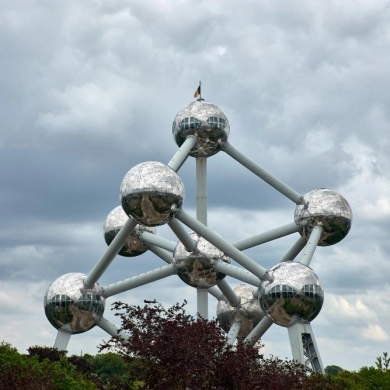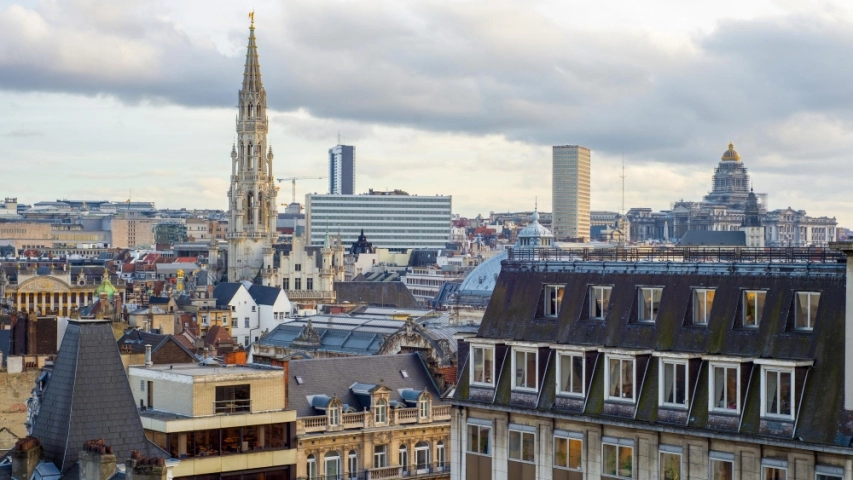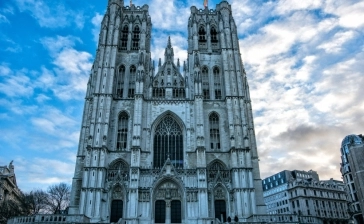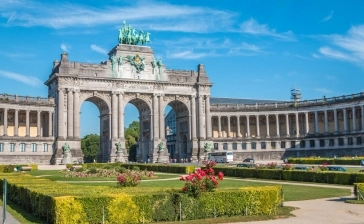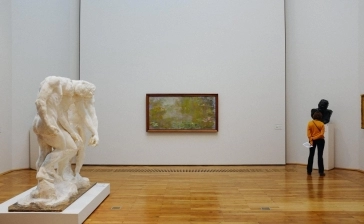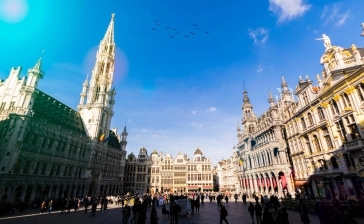Brussels, the capital of Belgium, is a vibrant and multicultural city that attracts millions of tourists every year. With a rich history spanning over a thousand years, it offers a fascinating blend of the old and the new, combining majestic palaces and cathedrals with innovative contemporary architecture. If you are a tourist using a wheelchair or a mobility scooter, you will be pleased to know that Brussels has made great efforts to be an accessible and welcoming city for everyone. In this text, we will tell you about the history of Brussels, some interesting anecdotes, and the main places you can visit, all designed to make your mobility easier.
Brussels was founded in the 10th century as a small fortress on an island in the Senne River. Over time, it grew into a prosperous city, especially during the Middle Ages when it became an important commercial hub in Europe. The city has also witnessed significant historical events, such as the Battle of Waterloo, which took place in 1815 a few kilometers from Brussels, marking the end of the Napoleonic Wars. During the 19th and 20th centuries, Brussels experienced major industrial development and became the home of various European institutions, earning its reputation as the "capital of Europe" due to the presence of the European Union headquarters.
One of the most famous anecdotes about Brussels involves Manneken Pis, a small bronze statue of a boy urinating. This peculiar symbol of the city has donned hundreds of different costumes over the years and has a fascinating history. Although there are many legends about its origin, one of the most popular is that it saved the city from an invasion by urinating on the fuse of a bomb, thus preventing destruction.
Another interesting anecdote involves the Atomium, a modern symbol of Brussels. Built for the 1958 World Expo, it was initially intended to be a temporary structure but became a lasting icon of the city due to its popularity.
Accessibility in Brussels
Brussels has implemented various initiatives to make the city more accessible for people with reduced mobility. Many of the main attractions are wheelchair accessible, with ramps, elevators, and adapted bathrooms available in most locations. Additionally, Brussels' public transport system, including many metro stations, trams, and buses, is accessible, making it easier to get around the city.
It is recommended to plan your visit in advance, checking the accessibility of each place you want to visit and verifying the current mobility conditions at tourist attractions. Below are some of the best attractions you can enjoy during your stay in Brussels.
What to Visit in Brussels
- The Grand Place
One of the most impressive places in Brussels is the Grand Place, a central square surrounded by historic buildings dating back to the 17th century. This square, a UNESCO World Heritage Site, is wheelchair accessible, although the cobblestone streets can be a bit uneven, so it is advisable to be cautious when moving around. In the Grand Place, you can admire the Town Hall and the King's House, and if you visit in August, you can enjoy the famous flower carpet that covers the square. - Manneken Pis
Just a few steps from the Grand Place, you will find the Manneken Pis statue, one of Brussels' most beloved attractions. The small bronze statue is easily accessible by wheelchair, as it is located on an open street corner. Don't be surprised if you see the boy dressed in a costume; he changes outfits several times a year, each with its own story. - The Atomium
The Atomium is a futuristic structure that represents a molecule magnified millions of times. It was built for the Expo 58 and today houses exhibitions on science, design, and technology. The Atomium’s ground floor is wheelchair accessible, and elevators are available to reach the lower spheres, although some upper areas may not be fully accessible due to stairs. From here, you will have stunning panoramic views of the city. - Royal Palace of Brussels
Although the Royal Palace is no longer the residence of the Belgian royal family, it remains one of the city's most impressive buildings. During the summer, the palace's rooms are open to the public, and entrance is free. The palace is wheelchair accessible, with elevators allowing access to most of the rooms. Additionally, the adjacent gardens are a perfect place to relax and enjoy an accessible walk. - Museum of Fine Arts (Musées Royaux des Beaux-Arts)
This museum houses one of the most important art collections in Europe, including works by Rubens, Magritte, and Bruegel. The museum is fully wheelchair accessible, with elevators and adapted bathrooms available. It is a must-see for art lovers and also offers interesting temporary exhibitions throughout the year. - Parc du Cinquantenaire
This large park is one of the green lungs of Brussels and an excellent place to stroll or relax in a peaceful environment. It is easily accessible by wheelchair, with paved paths running through the gardens. Inside the park, you will also find the Royal Museum of the Armed Forces and Military History, which is also accessible and offers a fascinating view of Belgium’s military history.
Accessible Transportation in Brussels
Getting around Brussels by wheelchair or mobility scooter is relatively easy thanks to the accessible transport options. Most buses and trams are equipped with ramps and have reserved areas for wheelchairs. The metro also has several accessible stations, although not all of them, so it is recommended to plan your routes in advance. Additionally, the city offers accessible taxis that can take you anywhere comfortably.
Additional Tips
• Advance reservations: If you plan to rent a mobility scooter or need additional equipment, it is advisable to book in advance, especially during the tourist high season.
• Uneven surfaces: Some historic areas of Brussels, such as the area around the Grand Place, have cobblestone streets that can be challenging for wheelchairs or scooters. Always carry a support device or companion if possible.
• Accessible bathrooms: Many museums, restaurants, and shopping centers have accessible bathrooms, but they are not available everywhere. A good option is to use mobile apps to help you find the nearest accessible bathrooms.
Conclusion
Brussels is a fascinating city, full of history, art, and culture, offering a rich experience for all its visitors. If you use a wheelchair or mobility scooter, you will be able to enjoy most of the attractions the city has to offer, thanks to the accessibility measures implemented in recent years. From the Grand Place to the Atomium, through the European Quarter, Brussels guarantees an unforgettable experience in an accessible and welcoming environment.
We hope you enjoy your visit to this beautiful city.
Here is detailed information about the most important tourist offices in Brussels, including the one at the airport, with details about their services, accessibility, and how to contact them.
Tourist Office at Grand Place The most central and visited tourist office in Brussels is located in the iconic Grand Place, a UNESCO World Heritage site.
Services offered:
- Free city maps and tourist guides.
- Information on events, tourist attractions, museums, and cultural activities.
- Purchase of public transport cards and the Brussels Card, which offers free access to museums and discounts on attractions.
- Booking of guided tours and recommendations on where to eat and stay.
Accessibility:
- Fully accessible for people with reduced mobility.
- Accessible entrance with no steps and wide hallways.
- Accessible restrooms available.
Contact details:
- Address: Hôtel de Ville, Grand Place, 1000 Brussels
- Phone: +32 (0)2 513 89 40
- Email: info@visit.brussels
- Website: visit.brussels
Tourist Office at Mont des Arts (BIP - Brussels Info Place)
Another key office is located in the BIP building (Brussels Info Place), at Mont des Arts, near major museums and the Royal Palace.
Services offered:
- General information about Brussels and the region.
- Interactive exhibitions on the history and culture of Brussels.
- Ticket sales for museums and cultural events.
- Maps, guides, and promotional materials.
Accessibility:
- Completely accessible for people with reduced mobility.
- Elevators available to access all areas of the building.
- Accessible restrooms for people with reduced mobility.
Contact details:
- Address: Rue Royale 2-4, 1000 Brussels
- Phone: +32 (0)2 513 89 40
- Email: info@visit.brussels
- Website: visit.brussels
Tourist Office at Brussels Central Station
The central station is a strategic point for tourists arriving by train from other parts of Europe or Belgium. The tourist office here provides a wealth of information.
Services offered:
- General information about Brussels and tourist activities.
- City maps and brochures.
- Assistance with hotel bookings and excursions.
- Information on Brussels public transport.
Accessibility:
- This office is accessible for people with reduced mobility, but some areas of the station may be less accessible due to its age.
- Accessible restrooms available in the station.
Contact details:
- Address: Brussels Central Station, Carrefour de l’Europe 1000 Brussels
- Phone: +32 (0)2 513 89 40
- Email: info@visit.brussels
- Website: visit.brussels
Tourist Office at Brussels Airport
The airport tourist office is an excellent reference point for tourists arriving in Brussels by plane. It is conveniently located in the arrivals terminal.
Services offered:
- Information on how to get to the city and main attractions.
- Brussels guides and maps.
- Information on public transport, taxis, and car rentals.
- Sales of the Brussels Card and public transport tickets.
Accessibility:
- Fully accessible for people with reduced mobility.
- Ramps and wide access points throughout the airport terminal.
- Accessible restrooms available in various locations within the terminal.
Contact details:
- Address: Brussels Airport, Arrivals Terminal, Zaventem, 1930 Brussels
- Phone: +32 (0)2 753 77 53
- Email: info@brusselsairport.be
- Website: brusselsairport.be
General Information on Accessibility at Tourist Offices:
All the mentioned tourist offices have implemented measures to ensure accessibility for people with reduced mobility. They have ramps or elevators in the buildings and are well adapted for wheelchairs. Additionally, accessible restrooms are available at all offices or nearby locations. In each of these offices, you can also receive personalized assistance to obtain information about the accessibility of tourist attractions, adapted transportation, and special services you may need during your visit. I hope this information helps you plan your visit to Brussels. Feel free to contact me if you need more details!
Tourist Card
Brussels offers a tourist card called the Brussels Card, which is very popular among visitors as it provides an excellent way to explore the city while saving on entrance fees and transportation. Below, I provide detailed information about the Brussels Card, its benefits, what it includes, prices, transportation options, duration, and accessibility aspects for people with mobility issues.
What is the Brussels Card?
The Brussels Card is a tourist card that offers free or discounted access to more than 40 museums and attractions in Brussels, along with benefits at selected shops and restaurants. You can also opt for a version that includes unlimited public transportation, making it easier to get around the city.
Included Attractions
The Brussels Card gives you free access to over 40 museums and tourist attractions in Brussels. Some of the highlights include:
- Magritte Museum – Dedicated to the work of Belgian surrealist René Magritte.
- Royal Museums of Fine Arts – Home to one of Europe’s most impressive art collections, with masterpieces by Rubens and Bruegel.
- Belgian Comic Strip Center – A museum dedicated to the art of comics, highly popular in Belgium.
- Atomium (50% discount) – An iconic symbol of Brussels since Expo 58.
- Brussels City Museum – Located in the Grand Place, it tells the story of the city through fascinating exhibitions.
- Cinquantenaire Museum – An impressive museum of archaeology and history.
- Musical Instruments Museum – One of the most comprehensive collections of musical instruments in the world.
- Natural Sciences Museum – Perfect for families, with exhibitions on dinosaurs and more. In addition to these, the card offers free entry to many other museums and monuments, as well as discounts on cultural activities and guided tours.
Public Transport with the Brussels Card
There are two main options with the Brussels Card:
- Basic Brussels Card: Includes only access to museums and discounts on other attractions.
- Brussels Card + Public Transport: In addition to access to museums and discounts, this option includes unlimited public transport for 24, 48, or 72 hours. This means you can use buses, trams, and metro operated by STIB/MIVB (Brussels' public transport company) without restrictions. This is a great benefit if you plan to get around the city by public transport, as Brussels is quite large, and taxi rides can be expensive. If you have mobility issues, Brussels public transport is well adapted for wheelchair users or mobility scooters. Many buses and trams are equipped with ramps and reserved spaces.
Brussels Card Prices
Prices for the Brussels Card vary depending on the duration you choose. These are the updated rates:
- 24 hours:
- Without public transport: €29
- With public transport: €37
- 48 hours:
- Without public transport: €39
- With public transport: €49
- 72 hours:
- Without public transport: €47
- With public transport: €61 The Brussels Card is valid from the first use, and its duration depends on the type of card you purchase (24, 48, or 72 hours).
How Does the Brussels Card Work?
- Once you purchase the Brussels Card, the card activates when you use it for the first time at an attraction or on public transport (if you chose the option with transport). From that moment, the validity time of 24, 48, or 72 hours begins, depending on the type of card you chose.
- You can use the Brussels Card once at each museum or attraction included. However, if you leave and return to the same attraction, you will not be able to reuse the card to enter again.
- For museums, you only need to present the card at the entrance. In the case of public transport, you will receive a separate STIB/MIVB card that you can use on trains, buses, and trams.
Is the Brussels Card Accessible for People with Mobility Issues?
Yes, most of the attractions and museums included in the Brussels Card are accessible for people with reduced mobility. Brussels has made significant efforts in recent years to improve accessibility to its main tourist attractions. Below are some important aspects of accessibility:
- Museums and Attractions: Many museums in Brussels, such as the Magritte Museum, Royal Museums of Fine Arts, and the Atomium, have wheelchair-accessible entrances with ramps and elevators available. They also usually have accessible restrooms.
- Public Transport: If you opt for the Brussels Card + Public Transport, the STIB/MIVB transport system is well adapted for people with reduced mobility. Buses have ramps and reserved areas for wheelchairs, and the main metro stations have elevators and adapted access points.
- Accessibility at Purchase Points: You can purchase the Brussels Card at various accessible points of sale, including tourist offices such as the one located at Grand Place, which is fully accessible.
Where to Buy the Brussels Card?
You can purchase the Brussels Card online through the official Brussels tourism website or directly at the city’s tourist offices, such as in Grand Place or at Brussels Airport. It is also possible to purchase it at some museums and tourist information points.
Contact details for purchasing at tourist offices:
- Tourist Office at Grand Place
- Address: Hôtel de Ville, Grand Place, 1000 Brussels
- Phone: +32 (0)2 513 89 40
- Website: visit.brussels
- Tourist Office at Brussels Airport
- Address: Brussels Airport, Arrivals Terminal, Zaventem, 1930 Brussels
- Phone: +32 (0)2 753 77 53
- Website: www.brusselsairport.be
Conclusion
The Brussels Card is an ideal option for tourists who want to explore Brussels and gain access to a wide variety of museums and attractions at reduced prices. If you have reduced mobility, the card offers excellent benefits, both in terms of accessibility to attractions and public transport. Additionally, with the option of unlimited public transport, it is a helpful tool for moving comfortably around the city.
With proper planning and the Brussels Card in hand, you can enjoy the best that Brussels has to offer without worrying about logistical details. Be sure to make the most of your visit!
Airport: Brussels Airport (IATA code: BRU), also known as Brussels International Airport, is one of the main airports in Europe and a key entry point for tourists and business travelers. Over the years, it has made significant efforts to improve accessibility and ensure a comfortable and smooth experience for people with reduced mobility, including those using wheelchairs or mobility scooters. Below is an explanation of the accessible advantages, services, and facilities that the airport offers to ensure an inclusive experience for all travelers.
Accessible Access Points
From the moment you arrive at the airport, whether by public transport or private vehicle, Brussels Airport is designed to be fully accessible for people with reduced mobility. Below are the different access points and how they are adapted:
- Access from public transport: If you arrive by train or bus, getting to the airport is straightforward. The train station is directly connected to the terminal on level -1, and there are elevators available to easily access the upper levels of the terminal from the train platform. The airport also offers accessible buses with ramps that can accommodate wheelchairs.
- Access from parking: The airport has adapted parking spaces for people with reduced mobility. Both short-term and long-term parking areas have reserved spots close to the main terminal entrances, making it easier to move from the car to the airport entrance. Additionally, the parking areas are equipped with ramps and elevators that lead directly to the terminal, eliminating any physical barriers.
Assistance Points for People with Reduced Mobility
One of the most important services Brussels Airport offers for people with reduced mobility is the Special Assistance Passenger Service. This service is designed to ensure that travelers with disabilities or reduced mobility can move easily through the airport from the moment they arrive until they board their flight, and vice versa.
- Booking assistance service: If you need assistance at the airport, it is recommended to request it in advance (at least 48 hours before your flight). You can do this through the airline you are flying with or directly with the airport. This ensures that the staff will be ready to assist you every step of the way.
- Assistance contact points: Once at the airport, you will find assistance contact points in various locations, including the parking areas and check-in zones. These points are well marked and staffed with personnel who can assist you with wheelchairs, internal transport, and any other needs you may have.
- Assistance process: Airport staff will accompany you through the entire process, from check-in and security control to the boarding gate. If necessary, they can help you board the plane and transport your wheelchair, whether it's manual or electric.
Accessible Waiting Areas
The airport also provides comfortable and accessible waiting areas for people with reduced mobility. These areas feature adapted seating, wide spaces for wheelchairs, and easy access to key services.
- VIP lounges and common areas: Both the common waiting areas and the airport’s VIP lounges are accessible. The lounges are equipped with reserved seating for people with reduced mobility, and many have outlets to charge devices like electric mobility scooters.
- Boarding gates: Boarding gates are fully accessible. If boarding requires the use of buses or accessing the plane from the tarmac, the airport staff will provide additional assistance, including adapted vehicles and lifts to ensure that people with reduced mobility can board safely and comfortably.
Accessible Restrooms
Brussels Airport has ensured that its restrooms are adapted for people with reduced mobility throughout the terminal.
- Location of accessible restrooms: In all major areas of the terminal (arrivals, departures, and transit zones), there are accessible restrooms clearly marked. These restrooms are larger than regular ones and equipped with support bars, lower sinks, and wide doors to allow easy access for wheelchairs.
- Cleaning and maintenance: The accessible restrooms are kept clean and well-maintained, and the airport’s cleaning staff ensures they are always in good condition for use.
Adapted Parking
The airport offers multiple adapted parking options for people with reduced mobility, both for short- and long-term stays.
- Short-term parking: Short-term parking (P1, P2, and P3) is located near the terminal, just a few minutes’ walk or wheelchair ride away. There are reserved parking spaces specifically for people with reduced mobility, located near the elevators that connect to the terminal.
- Long-term parking: If you need to leave your car for a longer period, the long-term parking also has reserved and accessible spaces for people with reduced mobility. These spaces are near the bus stops that will take you to the terminal quickly and comfortably. The buses connecting long-term parking with the terminal are equipped with wheelchair ramps.
Accessible Internal Transportation
Brussels Airport offers various internal transportation services that are fully adapted for people with reduced mobility.
- Elevators: Elevators are available throughout the terminal, allowing easy movement between different levels. The elevators are spacious enough for wheelchairs and mobility scooters, and they are clearly signposted.
- Internal transport vehicles: For longer distances within the airport, electric vehicles are available to transport people with reduced mobility from security control areas to boarding gates or transit zones. These vehicles are adapted for wheelchairs and can be requested at assistance points.
Additional Services
In addition to basic accessibility features, Brussels Airport offers several additional services that can be useful for people with reduced mobility:
- Free Wi-Fi: The entire airport offers free internet access, which can be useful for contacting family or assistance services during your time at the airport.
- Accessible shops and restaurants: Shops and restaurants inside the airport are accessible, with wide aisles and barrier-free entrances. Many restaurants also have adapted tables for wheelchair users.
- Assistance for passengers with hearing or visual impairments: In addition to assisting people with reduced mobility, the airport also offers support for passengers with hearing or visual impairments, with clear information screens and trained staff.
Conclusion
Brussels International Airport is one of the most accessible in Europe, with a special focus on ensuring that people with reduced mobility can enjoy a comfortable and hassle-free travel experience. With adapted access points, personalized assistance services, accessible restrooms, reserved parking, and an efficient and accessible public transport system, the airport ensures that all travelers can move easily and comfortably.
If you have any special needs or require additional assistance during your visit to the airport, feel free to contact them before your flight to ensure everything is prepared for your arrival.
How to Get from the Airport to the City Center
Getting from Brussels International Airport (Brussels Airport) to the city center is quite simple, even for a person with reduced mobility, as the available transportation options are adapted to ensure comfort and accessibility. Below, I’ll detail all the ways to reach the city center from the airport, with information on buses, trains, taxis, and more.
1. Train (Brussels Airport - Zaventem Station)
The train is one of the fastest and most convenient ways to travel from the airport to the center of Brussels. The airport has its own train station, Brussels Airport - Zaventem, located on level -1 of the terminal.
- Accessibility: The trains are accessible for people with reduced mobility. The stations are equipped with elevators, and the trains have reserved areas for wheelchairs. If you need additional help, you can request assistance from station staff in advance.
- Lines:
- IC (Intercity) line to Brussels Central and other major stations such as Brussels South and Brussels North.
- The direct journey from the airport to Brussels Central takes approximately 17 minutes.
- Schedule: Trains run every 10 to 15 minutes from 5:30 a.m. to midnight daily.
- Price:
- One-way ticket: Approximately €9-12 (depending on class).
- Tickets can be purchased at the automatic machines in the airport station or online.
- Website: www.belgiantrain.be
2. Bus (De Lijn and STIB/MIVB)
Buses from the airport are an affordable and accessible option to reach the center of Brussels. There are two main operators: De Lijn (the regional bus network) and STIB/MIVB (Brussels public transport operator).
De Lijn Buses:
- Lines:
- Line 272: To Brussels North. This bus stops at several stations in the north of Brussels and reaches the center in about 30-45 minutes.
- Line 471: A faster bus to Brussels North, with fewer intermediate stops.
- Accessibility: De Lijn buses are equipped with ramps that allow access for people in wheelchairs or mobility scooters. There are reserved wheelchair spaces on the buses.
- Schedule: Both buses run every 20 to 30 minutes from 5:00 a.m. to midnight.
- Price: A one-way ticket costs around €3. Tickets can be purchased at automatic machines in the terminal or directly on board the bus.
- Website: www.delijn.be
STIB/MIVB Buses:
- Line 12 (Airport Line): This is an express bus that connects the airport with central Brussels, stopping at key places like Schuman metro station and Brussels-Luxembourg.
- Accessibility: STIB/MIVB buses are fully adapted for people with reduced mobility, with access ramps and reserved spaces.
- Schedule:
- Monday to Friday: Runs approximately every 20 minutes from 5:30 a.m. to 8:00 p.m.
- Weekends and holidays: The bus 12 becomes Line 21, following a similar route but with more stops. It operates from 5:30 a.m. to 11:30 p.m.
- Price: A one-way ticket costs €4.50 if purchased from machines and €6 if bought on board.
- Website: www.stib-mivb.be
3. Taxi
Taxis are a convenient and accessible option for people with reduced mobility. At Brussels Airport, you will find adapted taxis for wheelchairs available 24/7. Below are the contact details of two taxi companies that offer adapted vehicles.
Taxi Hendriks
Taxi Hendriks specializes in transportation services for people with reduced mobility. They offer vehicles equipped with ramps and lifts that allow transporting people in wheelchairs comfortably and safely.
Taxis Autolux
Autolux is another taxi company that has adapted vehicles for people in wheelchairs. They offer 24-hour service, and it is recommended to book in advance.
- Phone: +32 (0)2 411 12 12
- Email: info@autolux.be
- Website: www.autolux.be
- Fare:
- The cost of the trip from the airport to the city center is approximately €45-50, depending on traffic and the time of day.
4. Private Transportation and Shuttle Services
In addition to traditional taxis, you can also book private shuttle services that are accessible from the airport to the city center. Companies like Welcome Pickups and Brussels Shuttle offer transfers in adapted vehicles, which can be a convenient option if you prefer a door-to-door experience with greater comfort.
5. Adapted Parking
If you prefer to rent a car or have someone pick you up, Brussels Airport offers accessible parking spaces for people with reduced mobility in all of its parking lots, both short-term and long-term. These spaces are close to the main entrances and are accessible via ramps and elevators.
- Prices:
- Short-term parking (P1, P2, P3): Approximate cost is €5 for the first hour.
- Long-term parking: Starts at €18 per day.
Conclusion
Getting from Brussels International Airport to the city center is convenient and accessible for people with reduced mobility, with various transportation options available. From accessible trains and buses to specialized taxis and private transfer services, there are multiple ways to get to the heart of Brussels safely and efficiently. Whether you prefer public transport or a more personalized service, Brussels ensures that you can move around with ease.
Accessible Transportation within Brussels
Brussels is a well-connected city that offers a wide variety of transportation options for all residents and visitors, including those using wheelchairs or with mobility issues. Public transport systems like buses, trams, metro, and trains are mostly adapted for people with reduced mobility, making it easy to move around the city safely and comfortably. Below is a detailed explanation of the various transport options available in Brussels, including schedules, prices, accessibility, and adapted taxi services.
1. Metro
Brussels' metro system, operated by STIB/MIVB, is a fast and efficient option for getting around the city. It consists of four metro lines:
- Line 1: Stockel – Gare de l'Ouest
- Line 2: Simonis (Leopold II) – Simonis (Elisabeth) (circular line)
- Line 5: Erasme – Herrmann-Debroux
- Line 6: Roi Baudouin – Simonis (Elisabeth)
Accessibility:
- Many metro stations are equipped with elevators and ramps, making them accessible for people in wheelchairs. However, not all stations are fully accessible, so it’s advisable to check station accessibility before traveling.
- Key stations like Gare Centrale, Gare du Midi, Schuman, and Rogier are adapted for people with reduced mobility.
- Metro trains have wide doors and reserved spaces for wheelchairs.
Schedules:
- The metro operates Monday through Friday from 5:30 a.m. to midnight.
- On weekends and holidays, the hours are similar, but train frequency is slightly lower, with trains running every 6 to 10 minutes during peak hours and every 15 minutes during off-peak hours.
Prices:
- Single ticket: €2.60 if purchased from a machine, or €2.10 with the rechargeable MOBIB card.
- Day pass: €7.50, providing unlimited access to metro, trams, and buses.
- People with disabilities may qualify for discounts or free travel, depending on their specific situation. It is recommended to check with STIB/MIVB for more details.
2. Tram
Brussels’ tram system is extensive and offers an excellent way to explore the city, connecting key areas and important neighborhoods. Some of the main tram lines include:
- Line 3: Esplanade – Churchill
- Line 4: Gare du Nord – Stalle (express line)
- Line 7: Heizel – Vanderkindere (one of the most useful routes to get around the city)
Accessibility:
- The newer, more modern trams are adapted for wheelchair users, with low platforms and automatic ramps. However, some older trams may not be fully accessible, so it's advisable to check which lines are operated by modern trams.
- Tram stops are clearly marked with icons indicating accessibility.
Schedules:
- Trams run every 6 to 15 minutes, depending on the line and time of day.
- Service starts around 5:30 a.m. and continues until about midnight.
Prices:
- The fare system is the same as the metro, with single tickets costing €2.60 (or €2.10 with a MOBIB card) and day passes available for €7.50.
3. Bus
Brussels has an extensive bus network operated by STIB/MIVB and De Lijn (the regional transport company for Flanders). Buses are an accessible and economical option for getting around the city and surrounding areas.
Accessibility:
- Buses are well-equipped for people with reduced mobility. Most buses have automatic ramps that allow access for wheelchairs and mobility scooters, as well as reserved areas for people with disabilities.
- The busiest bus stops are adapted with barrier-free access.
Main Lines:
- Line 71: One of the most popular routes, connecting the center of Brussels with the Université Libre de Bruxelles (ULB), passing through the European Quarter.
- Line 95: Connects Central Station with the European Quarter and Louise Station.
Schedules:
- Buses run from 5:30 a.m. to midnight, with frequencies varying between 10 and 20 minutes depending on the line and time of day.
- On weekends and holidays, service is less frequent.
Prices:
- The same fare system as the metro and tram applies, with single tickets costing €2.60 or €2.10 with the MOBIB card.
4. Taxis
For those who prefer door-to-door service or need more flexibility, taxis are a comfortable and accessible option. Several taxi services in Brussels offer adapted vehicles for people with reduced mobility, including taxis with ramps or wheelchair lifts.
Adapted Taxi Companies:
- Taxi Hendriks
- Phone: +32 (0)2 752 98 00
- Email: info@hendriks.be
- Website: www.hendriks.be
- Hendriks specializes in transporting people with reduced mobility. Their vehicles are equipped with ramps and wheelchair lifts, and it is recommended to book in advance.
- Autolux
- Phone: +32 (0)2 411 12 12
- Email: info@autolux.be
- Website: www.autolux.be
- Autolux also offers adapted vehicles for wheelchair users and guarantees quality service 24 hours a day. It is advisable to book in advance to ensure availability.
Taxi Fares:
- The cost of a taxi ride from the center of Brussels to any location within the Brussels-Capital region is approximately €10 to €20, depending on distance and traffic.
- A ride from the airport to the center of Brussels costs approximately €45 to €50.
5. Trains
Regional trains operated by SNCB/NMBS connect Brussels with other cities and nearby municipalities. Trains are also a useful option for traveling within Brussels, as many major stations like Bruxelles-Central, Bruxelles-Midi, and Schuman are well connected.
Accessibility:
- Trains are adapted for people with reduced mobility. Major stations have elevators and ramps that provide access to platforms, and trains have reserved areas for wheelchairs.
- If you need additional assistance, it is advisable to request help in advance through the SNCB website.
Schedules:
- Trains operate from 5:30 a.m. to 11:00 p.m. with frequencies varying between 15 and 30 minutes.
Prices:
- Prices vary depending on the distance, but tickets for short journeys within Brussels typically cost between €2 and €5.
European Quarter:
The European Quarter of Brussels is one of the city's most emblematic and vibrant areas, where the old and the modern come together to create an urban landscape rich in history, politics, and contemporary architecture. This tour, which lasts a few hours, will take you to discover the most interesting points in the area. It is ideal for someone in a wheelchair, as the accessibility in this neighborhood has been carefully designed, with wide sidewalks, ramps, and urban planning that allows for smooth mobility.
We begin the tour at Place Luxembourg, the heart of the European Quarter. Upon arrival, you find an open square surrounded by historic and modern buildings. Right in front of you stands the imposing European Parliament, one of the most important institutions of the European Union. This building, known as the Paul-Henri Spaak building, is the center of European democracy and is fully adapted for people with reduced mobility. Ramps and elevators ensure that you can easily move around its various areas. If you wish, you can take a guided tour, which includes an interactive introduction to the history of the European Union, as well as the opportunity to visit the hemicycle where laws affecting millions of people across Europe are debated.
After exploring the European Parliament, we continue our walk through Leopold Park, one of the most beautiful green spaces in the European Quarter. The park is a true oasis within the city's hustle and bustle, with wide, smooth paths that make it completely accessible for a person in a wheelchair. As you stroll through the park, you can enjoy the tranquility of the lake that runs through it, where ducks and swans are often seen. Strategically placed benches invite you to take a break and admire the beauty of the area. In the park, you will also find the Museum of Natural Sciences, an excellent place to learn about the evolution of life on Earth. Like many of the attractions in the area, the museum is well-adapted with elevators and barrier-free access.
Following our route, we head to Rue de la Loi, one of the main arteries of the European Quarter. Here, you are fully immersed in the political life of Brussels, as this street is lined with important buildings of European administration. On this avenue is the Berlaymont Building, headquarters of the European Commission. This iconic building, with its four-arm star shape, is one of the most recognizable symbols of the European Union. Although it is not open to the general public, the exterior is impressive, and it’s interesting to see how modern architecture dominates this part of the city.
From Rue de la Loi, we make our way to Cinquantenaire Park, one of the largest and most majestic parks in Brussels. This space was created to commemorate the 50th anniversary of Belgium’s independence and is a must-see stop on this tour of the European Quarter. Upon arrival, you are greeted by a massive triumphal arch that is visible from much of the city. The park is completely accessible, with wide, well-paved paths, ideal for someone in a wheelchair. As you stroll through the park, you can admire the surrounding museums, such as the Museum of Military History and the Cinquantenaire Museum, both accessible and housing fascinating collections ranging from archaeology to art history.
At the end of the park, if you look up, you can see the triumphal arch in all its splendor. If you have time and feel adventurous, you can take an accessible elevator that will take you to the top of the arch, where you’ll get breathtaking panoramic views of Brussels and the European Quarter. Although this option is not well-known, it is a unique experience and completely accessible for people with reduced mobility.
After enjoying the park, we head to Schuman Square, the epicenter of European political life. This square, surrounded by modern office buildings, is named after Robert Schuman, one of the founding fathers of the European Union. It is interesting to observe the contrast between the fast-paced political life and the calm, accessible public spaces that surround it. The Schuman Roundabout is one of the busiest areas of the neighborhood, but fortunately, the crosswalks are wide, and the sidewalks are well-leveled, making movement easy for anyone in a wheelchair.
Continuing along Rue Archimède, we arrive at the Europa Building, an impressive architectural work that is the headquarters of the European Council and the Council of the European Union. This building is easily recognizable by its glass structure that envelops an ancient core, symbolizing the fusion of tradition and modernity in European politics. Like the other institutional buildings, the Europa Building is fully adapted, with ramps, elevators, and accessible entrances.
We end our tour of the European Quarter by returning to Place Luxembourg, where you can take a break at one of the accessible cafés lining the square. Many of them have large terraces where you can enjoy a drink while watching the vibrant atmosphere of the neighborhood. If you have time, you can visit the Parlamentarium, the European Parliament's visitor center, which offers an accessible, multimedia experience, allowing all visitors to learn more about the history and functions of the European Union.
In summary, the European Quarter of Brussels is a lively, history-filled area that perfectly combines political power with architectural beauty and the tranquility of green spaces. With a route designed for people in wheelchairs, you can enjoy all the main attractions without worrying about accessibility. From the large parks to the impressive buildings of the European Union, this neighborhood offers a unique glimpse of Brussels that you shouldn’t miss.
Here is information about three accessible restaurants in Brussels, all suitable for people with mobility issues. You’ll find details on their accessibility, signature dishes, and contact information.
1. Le Plattesteen
Description: Le Plattesteen is located in the heart of Brussels and is known for its traditional Belgian cuisine. This cozy restaurant is perfect for enjoying classic regional dishes such as mussels, beef stew, and other Belgian favorites.
Signature Dish: Their standout dish is Carbonnade Flamande, a Belgian beef stew slow-cooked in dark beer, served with crispy fries. This is a classic of Belgian cuisine, excellently prepared at Le Plattesteen.
Accessibility: Le Plattesteen is accessible for people with reduced mobility. The entrance is flat, without steps, and there is ample space inside for easy movement. The tables are spaced out enough to allow comfortable navigation for wheelchair users. The restrooms are also adapted, featuring wide access and support bars.
Contact Details:
- Address: Rue du Marché au Charbon 41, 1000 Brussels, Belgium
- Phone: +32 2 512 32 93
- Email: info@leplattesteen.be
- Website: Not available
2. Noordzee Mer du Nord
Description: Noordzee Mer du Nord is a popular seafood spot in Brussels, known for its fresh fish and seafood dishes. Located near Place Sainte-Catherine, the restaurant offers counter service where you can order grilled fish and oysters, among other seafood delights. It's a casual place, ideal for seafood lovers.
Signature Dish: Their Fish Soup, made with fresh ingredients and seafood of the day, accompanied by crusty bread, is a highlight. This dish is comforting and delicious, enjoyed by many diners outdoors.
Accessibility: The restaurant is accessible for people with reduced mobility. Outdoor seating is easily reachable from the street, and the counter is at a convenient height for wheelchair users. The restrooms are adapted, providing ample space and support bars.
Contact Details:
- Address: Rue Sainte-Catherine 45, 1000 Brussels, Belgium
- Phone: +32 2 513 11 92
- Email: info@noordzeemer.be
- Website: www.noordzeemer.be
3. Chez Léon
Description: Chez Léon is an iconic restaurant located near the Grand Place, specializing in traditional Belgian cuisine. It's especially famous for its moules-frites (mussels with fries), a quintessential Belgian dish. The atmosphere is lively and friendly, making it a great place to experience authentic Belgian dining.
Signature Dish: The must-try dish here is the Moules-frites. The mussels are cooked in a rich white wine sauce and served with crispy fries—a favorite among both tourists and locals.
Accessibility: Chez Léon is accessible for people with reduced mobility. The main entrance is equipped with ramps, and the restaurant’s interior is spacious, allowing for easy wheelchair mobility. The restrooms are fully adapted, with support bars and plenty of space for wheelchairs.
Contact Details:
- Address: Rue des Bouchers 18, 1000 Brussels, Belgium
- Phone: +32 2 511 14 15
- Email: info@chezleon.be
- Website: www.chezleon.be
